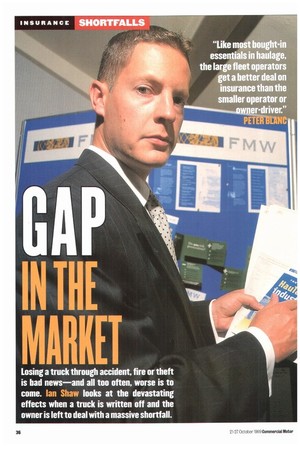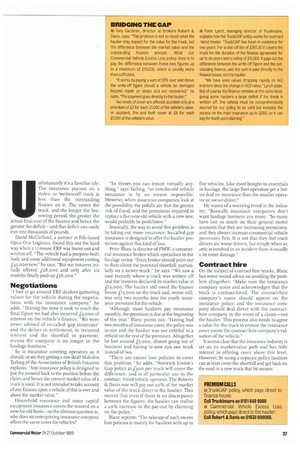GAP INT E MARKET
Page 38

Page 39

If you've noticed an error in this article please click here to report it so we can fix it.
Losing a truck through accident, fire or theft is bad news—and all too often, worse is to come. Ian Shaw looks at the devastating effects when a truck is written off and the owner is left to deal with a massive shortfall. Unfortunately it's a familiar tale. The insurance pay-out on a stolen or Written-off truck is less than the outstanding finance on it. The newer the truck, and the longer the borrowing period, the greater the actual final cost of the finance and hence the greater the deficit—and that deficit can easily run into thousands of pounds.
David McClelland, a partner at Fife-based Opus One Logistics, found this out the hard way when a 17-tonne ERF was burnt out and written off "The vehicle had a purpose-built body and some additional equipment costing f45,000 new," he says. "But our insurers initially offered £28,000 and only after six months finally paid-up £36,000."
Negotiations .. i had to go around ERF dealers gathering values for the vehicle during the negotiations with the insurance company," he adds. "During the time it took to reach the final figure we had also incurred £3,000 of interest on the vehicle's finance. "We were never advised of so-called 'gap insurance' and the delays in settlement, in incurred interest and the shortfall in payment, means the company is no longer in the haulage business."
So is insurance covering operators as it should, or are they getting a raw deal? Malcolm Tarling of the Association of British Insurers explains: "Any insurance policy is designed to put the insured back to the position before the claim, and hence the current market value of a truck is used. It is not intended to take account of any finance upon a vehicle, if this is over and above the market value."
Household insurance and some capital equipment insurance covers the insured on a new-for-old basis—so the obvious question is, why does no enterprising insurance company offers the same cover for vehicles? "In theory you can insure virtually anything," says Tarling, "so new-for-old vehicle insurance is by no means impossible. However, when insurance companies look at the possibility, the pitfalls are that the greater risk of fraud, and the premiums required to replace a five-year-old vehicle with a new one, would probably be prohibitive."
Ironically, the way to avoid this problem is by taking out more insurance. So-called gap insurance is designed to offer the haulier protection against this kind of loss.
Peter Blanc is director of FMW, a commercial insurance broker which specialises in the haulage sector. "Every broker should point out to their client the potential shortfall, particularly on a newer truck," he says. "We saw a case recently where a truck was written off and the insurers declared its market value at £12,000. The haulier still owed the finance house £15,000 on the truck and, worse still, was only two months into the yearly insurance premium for the vehicle.
"Although most hauliers pay insurance monthly, the premium is due at the beginning of the year," Blanc points out. "Having had two months of insurance cover, the policy was in use and the haulier was not entitled to a refund on the rest of the premium. Altogether he lost around £5,000, almost going out of business and having to now run one truck instead of two.
"There are excess Loss policies to cover this problem," he adds. "Norwich Union's Gap policy at £300 per truck will cover the difference, and is of particular use to the contract -hired vehicle operator. The Roberts & Davis one will pay out 2o% of the market value of the truck direct to the haulier. This means that even if there is no discrepancy between the figures, the haulier can realise a zo% increase in the pay-out by claiming on the policy."
Blanc reports: "The take-up of such excess loss policies is mainly for hauliers with up to
five vehicles. Like most bought-in essentials in haulage, the large fleet operators get a better deal on insurance than the smaller operator or owner-driver."
He warns of a worrying trend in the industry: "Basically insurance companies don't want haulage business any more. "So many have lost so much on their general motor accounts that they are increasing premiums, and they always increase commercial vehicle premiums first. It is not that they feel truck drivers are worse drivers, but simply when an attic is involved in an accident there is usually a lot more damage."
Contract hire
On the subject of contrac t-hire trucks, Blanc has some sound advice on avoiding the problem altogether: "Make sure the insurance company notes and acknowledges that the truck is contract-hired. The contract-hire company's name should appear on the insurance policy: and the insurance company should deal direct with the contracthire company in the event of a claim—not the haulier. This process also needs to agree a value for the truck to ensure the insurance cover meets the contract hire company's valuation of the vehicle."
It seems dear that the insurance industry is set on its market-value path and has little interest in offering cover above this level. However, by using a separate policy hauliers can at least cover the shortfall and get back on the road in a new truck that bit sooner.
PREMIUM CALLS
• TruckGAP policy, which pays direct to finance house:
Call Truckin.sure on 0181 649 9900 in Commercial Vehicle Excess Loss policy, which pays direct to the haulier: Call Robert & Davis on 01638 608060. BRIDGING THE GAP • Tony Gardiner, director at brokers Robert &, Davis, says: "The problem is not so much what the haulier may expect for the value for the truck, but the difference between the market value and the outstanding finance amount. What our Commercial Vehicle Excess Loss policy does is to pay the difference between these two figures up to a maximum of £10,000, which is usually more than sufficient.
"It works by paying a sum of 20% over and above the write-off figure should a vehicle be damaged beyond repair or stolen and not recovered," he adds. "The payment goes directly to the haulier."
Two levels of cover are offered: accident-only at a premium of £3 for each 21,000 of the vehicle's value, or accident, fire and theft cover at £4 for each 11,000 of the vehicle's value. • Peter Lynch, managing director of Truckinsure, explains how the TruckGAP policy works for contract -hired trucks: "TruckGAP has been in existence for two years. For a one-off fee of £367.50 it covers the truck for the duration of the finance agreement for up to six years and a ceiling of 110,000. It pays out the difference between the write-off figure and the outstanding finance, and the sum is paid directly to the finance house, not the haulier.
"We have seen values dropping rapidly on 4x2 tractors since the change in VED rates," Lynch adds. But of course the finance remains at the same level, giving some hauliers a large deficit if the truck is written off. The vehicle must be comprehensively insured for our policy to be valid but includes the excess on the main insurance up to £350, so it can pay for itself upon claiming."












































































































